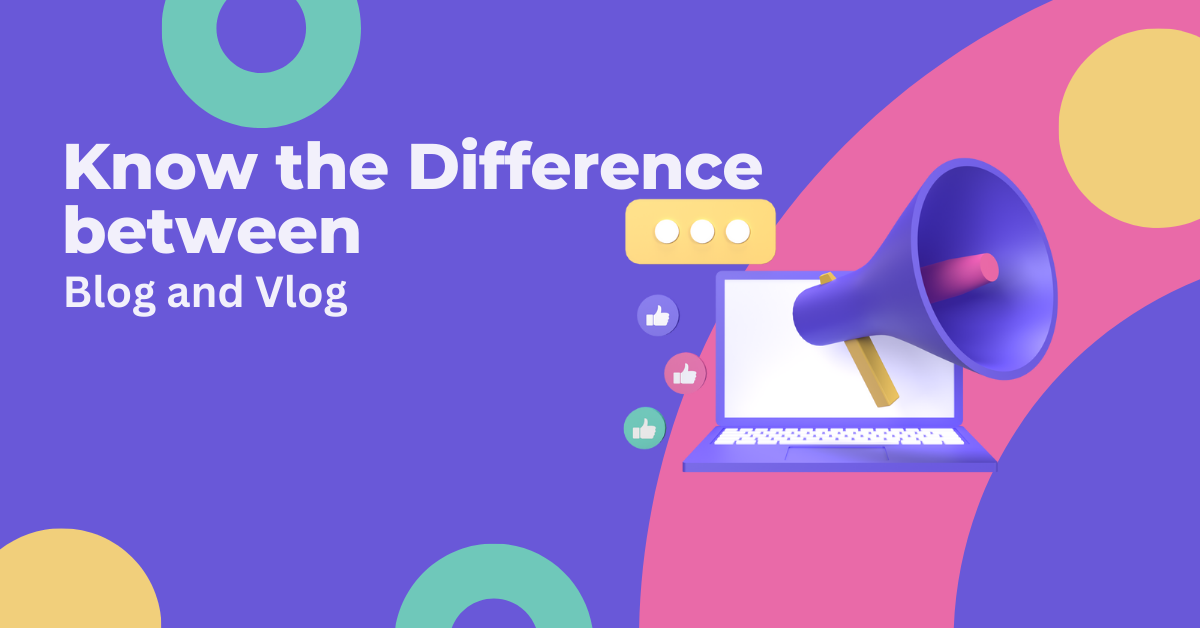
In the digital age, content creation has evolved significantly, providing creators and consumers with various mediums to express and consume information. Two popular forms of content creation are blogging and vlogging, which are often used interchangeably. However, they are distinct in their own ways, serving different purposes and engaging different audiences. In this comprehensive guide, we will explore the key differences between blogs and vlogs, shedding light on their unique characteristics, advantages, and limitations.
Definition of Blog and Vlog
Blog:
A blog, short for “weblog,” is a text-based platform where individuals or organizations regularly publish written content on various topics. These written entries, known as “blog posts,” are typically organized in reverse chronological order. Blogs often include multimedia elements, such as images, videos, and links, to enhance the content’s richness and engagement.
Vlog:
A vlog, a portmanteau of “video” and “blog,” is a video-based platform where creators share their thoughts, experiences, or information through videos. Vlogs can be highly personal and often feature the vlogger directly addressing the audience while capturing real-life situations, events, or narratives.
Content Format
Blog:
- Primarily text-based content.
- May include images, infographics, and multimedia to complement text.
- Written in a formal or informal style, depending on the blogger’s preference and the target audience.
- Typically contains headings, subheadings, and paragraphs for structured information presentation.
Vlog:
- Video-based content, with minimal or no text.
- Utilizes visual and auditory elements for storytelling.
- Highly reliant on the vlogger’s presentation style, including tone, body language, and expressions.
- Content is delivered through video clips, often edited for better engagement.
Medium of Expression
Blog:
- Ideal for those who enjoy writing and have strong writing skills.
- Allows for in-depth discussions and explanations.
- Readers can consume content at their own pace, re-reading as needed.
- Provides an opportunity for bloggers to establish themselves as experts in their niche through well-researched articles.
Vlog:
- Suited for individuals who are comfortable in front of the camera and can effectively communicate through video.
- More engaging for visual and auditory learners.
- Offers a direct, personal connection with the audience, as viewers see and hear the vlogger.
- Well-suited for sharing experiences and emotions through real-time video footage.
Interactivity
Blog:
- Comments sections allow for written discussions and feedback.
- Readers can engage with the content by leaving comments or sharing the blog post.
- Limited interaction with the blogger directly.
- Bloggers can respond to comments, fostering a sense of community.
Vlog:
- Encourages real-time interaction through live streaming and chat.
- Viewers can comment on the video while watching, creating a sense of immediate connection.
- Vloggers can respond verbally to comments during live broadcasts.
- Provides a more personal and interactive experience.
Accessibility
Blog:
- Accessible to those with visual or hearing impairments, as text can be converted into braille or read aloud using screen-reading software.
- Search engines can easily index and rank blog content, making it discoverable through search results.
- Well-suited for those in regions with slower internet connections or limited bandwidth.
Vlog:
- May pose accessibility challenges for individuals with visual or hearing impairments.
- Search engines may struggle to index video content, making it less discoverable through search results.
- Requires higher internet bandwidth and faster connections for streaming without interruptions.
Monetization Opportunities
Blog:
- Monetization options include display advertising, sponsored posts, affiliate marketing, and selling digital products like e-books.
- Easier to track and analyze traffic, making it convenient for advertisers.
- Well-established monetization strategies for bloggers, with clear performance metrics.
Vlog:
- Monetization possibilities primarily involve ads within videos, sponsored content, merchandise sales, and channel memberships.
- Requires substantial viewership and watch time to generate significant revenue.
- Ad revenue can fluctuate due to changes in YouTube policies or advertiser preferences.
Content Longevity
Blog:
- Blog posts have a longer lifespan and can remain relevant for years.
- Content updates are relatively straightforward and can keep older posts up-to-date.
- Blog archives accumulate over time, providing a rich source of information for readers.
Vlog:
- Video content may have a shorter lifespan due to rapidly evolving trends and technology.
- Updating video content can be more challenging, as it often involves reshooting or re-editing.
- Video archives are not as easily navigable as blog archives, making it harder for viewers to access older content.
Portability and Sharing
Blog:
- Easy to share blog posts through social media, email, or direct links.
- Readers can quickly access and share specific articles with their network.
- Blog content can be readily repurposed for e-books, email newsletters, and more.
Vlog:
- Video sharing often takes place on video-sharing platforms like YouTube.
- Sharing vlogs may involve sharing links or embedding videos on websites.
- Less portable for repurposing, as videos are primarily consumed in their original format.
Content Production and Editing
Blog:
- Bloggers have more control over the writing process, from drafting to publishing.
- Editing and proofreading can be done before publication.
- Bloggers can maintain consistent formatting and style throughout their content.
Vlog:
- Video production can be more time-consuming, involving filming, editing, and post-production.
- Editing video content may require more technical skills and software.
- Variability in video quality may occur, affecting the overall viewer experience.
Search Engine Optimization (SEO)
Blog:
- Blog content can be optimized for search engines, making it more discoverable.
- Keywords and meta tags help improve search rankings.
- Bloggers have more control over SEO and can make adjustments as needed.
Vlog:
- SEO for videos is different and may involve video title, description, and tags.
- YouTube is a primary search engine for video content, making ranking on the platform crucial.
- Vloggers may have less control over external search engine optimization.
Learning Curve
Blog:
- Blogging has a relatively low entry barrier, especially for those with strong writing skills.
- Learning to write effectively and structure content is essential.
- Familiarity with content management systems (CMS) is helpful.
Vlog:
- Vlogging has a steeper learning curve, involving video recording, editing, and presentation skills.
- Requires investment in video equipment, software, and possibly a dedicated workspace.
- Vloggers need to engage and entertain an audience through video.
Privacy and Security
Blog:
- Bloggers can maintain greater control over their privacy and security.
- Content can be published anonymously if desired.
- Limited risk of personal safety concerns for bloggers.
Vlog:
- Vloggers often reveal their identity and personal life in videos.
- Greater exposure may lead to privacy concerns and potential risks.
- Vloggers should be cautious about sharing sensitive information and locations.
Top Logo Design Company in Noida
Storage and Hosting
Blog:
- Blog content can be hosted on various platforms, including free blogging platforms or self-hosted websites.
- Bloggers have control over their choice of hosting and storage.
Vlog:
- Video content hosting is typically done on dedicated platforms like YouTube or Vimeo.
- Hosting videos on personal websites may require significant storage and bandwidth resources.
Audience Engagement
Blog:
- Engagement is primarily text-based, involving comments and social media interaction.
- Content discussion often takes place in written form.
- Bloggers can build a dedicated readership through regular updates and valuable content.
Vlog:
- High potential for emotional connection with the audience due to visual and auditory cues.
- Viewers can form a strong attachment to vloggers, feeling like they know them personally.
- Comments and live chat enable real-time interaction with viewers.
Niche Selection
Blog:
- Suitable for a wide range of niches, from travel and lifestyle to technology and finance.
- Bloggers can establish authority through well-researched and informative content.
- Competitive niches may require a unique angle to stand out.
Vlog:
- Often used for niches where visual or real-time demonstration is beneficial, such as beauty, gaming, and travel.
- Personal vlogs can focus on everyday life and experiences.
- Competition may be lower in some niches compared to the saturated blogosphere.
Passion and Dedication
Blog:
- Requires a passion for writing and dedication to regular content creation.
- Bloggers often work alone or with minimal assistance.
- The process can be isolating, but it allows for complete creative control.
Vlog:
- Demands passion for video creation and a willingness to appear on camera.
- May involve more collaborative efforts, such as video editing or scriptwriting.
- Vloggers often have a visible presence and must adapt to an audience’s expectations.
Flexibility
Blog:
- Allows for flexible content scheduling and publishing.
- Bloggers can choose when to publish, making it easier to balance with other commitments.
- Content can be pre-written and scheduled in advance.
Vlog:
- May require stricter scheduling, especially for regular vlogs.
- Consistent video uploads are crucial for building and retaining an audience.
- The video creation process may be more time-sensitive.
Adaptation to Trends
Blog:
- Can easily adapt to changing trends by updating or creating new blog posts.
- Integration of multimedia and interactive elements keeps content fresh.
- Bloggers can stay current by covering trending topics in their niche.
Vlog:
- Adaptation to trends may involve creating entirely new videos, which can be time-consuming.
- Video content can become outdated quickly if it relates to specific events or trends.
- Vloggers must be agile in their content creation to stay relevant.
Cost of Entry
Blog:
- Minimal financial investment required, especially on free blogging platforms.
- Costs may include domain registration and web hosting for self-hosted blogs.
Vlog:
- Involves higher initial costs for video equipment, including cameras, microphones, and video editing software.
- Ongoing costs may include storage, video production, and marketing expenses.
Read More :- Best Digital Marketing Agency in Noida
Conclusion
In the dynamic world of online content creation, both blogs and vlogs offer unique avenues for expression and engagement. The choice between blogging and vlogging ultimately depends on your interests, skills, and target audience. While blogs excel in written content, vlogs leverage the power of visual and auditory storytelling. To make an informed decision, consider your passion, resources, and goals, as both mediums offer opportunities to share your voice with the world. Whether you become a blogger or a vlogger, the key to success lies in creating valuable and engaging content that resonates with your audience.


